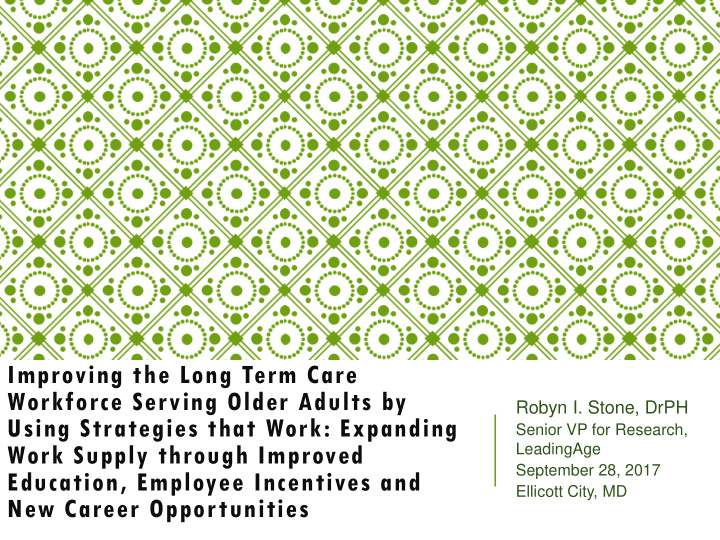



Improving the Long Term Care Workforce Serving Older Adults by Robyn I. Stone, DrPH Using Strategies that Work: Expanding Senior VP for Research, Work Supply through Improved LeadingAge September 28, 2017 Education, Employee Incentives and Ellicott City, MD New Career Opportunities
DEFINING THE SECTOR Post acute SNF and home health care Residential care – nursing homes, AL, memory care Independent living-market rate & subsidized HCBS – home care, personal care, IADL help Supportive services – transportation, meals, etc. Care/service coordination across settings and acute/primary care
MULTIDISCIPLINARY NATURE OF THE OCCUPATIONS Medical/social/environment intersection Range of job categories Clinicians –Nurses/social workers-lead clinicians –Physicians – relatively minor –Therapists – PT, OT, ST –Pharmacists –Dietician –Health educators Administrators and managers
OCCUPATIONS, CONT. Frontline professionals (60-80% of care) CNAs Home health/home care aides Personal care attendants Dietary aides Family and friends Informal Paid through consumer direction
LONG-TERM TRENDS The emerging “care gap” Shift from institutional to in-home and community-based settings More ethnically/racially diverse older adults and staff More highly educated, demanding older adults
LONG-TERM TRENDS, CONT. Greater disparity between “haves” and “have-nots” Expansion of consumer-directed service systems Impact of new technologies
IMPORTANCE OF THIS SECTOR Growth of the elderly population = fastest growing occupations in many localities New models of care = new types of jobs in this sector Economic driver in many communities – rural & other worker shortage areas Quality = Quality workforce!
CHALLENGES TO WORKFORCE DEVELOPMENT Recruitment challenges Retention challenges Lack of competent, quality staff – not just warm bodies!
REASONS FOR CHALLENGES: SOCIETAL LEVEL Undervalued sector across all occupations Ageism leads to lack of attention and investment Jobs seen as easy, default after “burnout”
REASONS FOR CHALLENGE: POLICY LEVEL Inadequate public reimbursement Lack of universal LTSS financing Medicaid viewed as welfare program Uneven regulation; focuses on #s of staff Lack of intentional education policy Immigration policy?
REASONS FOR CHALLENGES: WORKPLACE LEVEL Lack of quality supervisors Inadequate in-service Lack of career mobility Inadequate compensation/benefits Not competitive technologically
POLICY SOLUTIONS Tying Medicare/Medicaid reimbursement directly to workforce development Include workforce indicators in quality measures Target use of GME dollars, other federal & state dollars to this sector Support investment in these jobs in worker shortage/disadvantaged communities Use immigration policy to target Explore delegation opportunities
EDUCATIONAL SOLUTIONS Develop faculty & curricula Develop quality clinical & management placements Expand career ladder opportunities through apprenticeship programs Reframing programs for displaced or older workers
WORKPLACE SOLUTIONS Become employers of choice Create Malcolm Baldridge Program for this sector Develop innovative career ladders & lattices Support quality management & supervision
L EADING A GE C ENTER FOR W ORKFORCE S OLUTIONS VP for Workplace Initiatives Center for Workforce Solutions - http://www.leadingage.org/workforce Three parts of the website have received the most attention 1. The Workforce Crisis (e.g. Factsheet) 2. Tools (e.g. Turnover Calculator) 3. Promising Practices Major Activities – Development of a National Strategic Plan on Workforce
Recommend
More recommend